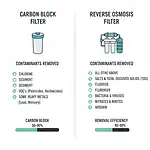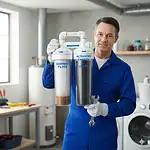Choosing the Right Filtration Method Matters
When it comes to home water filtration, carbon filters and reverse osmosis (RO) systems are two of the most common—and most misunderstood—technologies. Many homeowners install one thinking it covers everything, only to discover their system doesn’t remove certain contaminants.
So, what’s the real difference? And which one should you use for your water? In this guide, we’ll explain how each technology works, what contaminants they remove, and when it makes sense to combine them for the cleanest, safest water possible.

Carbon filters use activated carbon to trap chlorine, odors, and chemicals through adsorption, improving taste and smell, while reverse osmosis filters use a semi-permeable membrane to remove dissolved solids, salts, and heavy metals for near-pure water.
1. How Carbon Filters Work
Activated carbon filters rely on a natural process called adsorption—where contaminants stick to the surface of carbon granules or blocks as water passes through.
There are two main types:
- Granular Activated Carbon (GAC): Loose carbon particles, faster flow, slightly less filtration precision.
- Carbon Block Filters: Densely compressed carbon for higher removal efficiency and finer filtration (down to 0.5 microns).
What Carbon Filters Remove
- Chlorine and chloramines
- Volatile organic compounds (VOCs)
- Herbicides and pesticides
- Bad taste and odor
- Trihalomethanes (THMs)
What They Don’t Remove
- Dissolved salts and minerals
- Nitrates or fluoride
- Heavy metals (unless paired with KDF media)
- Microbial contaminants
💡 Think of carbon filters as “taste and odor polishers”—excellent for improving water quality, but not full purifiers.
2. How Reverse Osmosis Works
Reverse osmosis (RO) is a more advanced, multi-stage purification process. It forces water through a semi-permeable membrane that blocks dissolved solids and microscopic contaminants.
An RO system typically includes:
- Sediment pre-filter – removes sand, dirt, and rust.
- Carbon pre-filter – removes chlorine (protects the membrane).
- RO membrane – separates water from dissolved impurities.
- Post-carbon filter – polishes taste before dispensing.
The result? Water that’s 95–99% pure.
What RO Removes
- Total dissolved solids (TDS)
- Nitrates, sulfates, fluoride
- Arsenic, lead, mercury
- Bacteria and viruses (if membrane intact)
- Sodium and hardness minerals
What RO Doesn’t Remove
- Certain VOCs (if no carbon stage)
- Chlorine (damages the membrane if unfiltered)
- Some very small organic compounds
3. Key Differences: Carbon vs. Reverse Osmosis
| Feature | Carbon Filter | Reverse Osmosis |
|---|---|---|
| Main Function | Adsorbs chemicals & odors | Physically removes dissolved solids |
| Micron Rating | 0.5–5 microns | 0.0001 micron |
| Removes Chlorine? | ✅ Yes | 🚫 Only with pre-filter |
| Removes Fluoride? | ❌ No | ✅ Yes |
| Removes Heavy Metals? | Limited (with KDF) | ✅ Yes |
| Flow Rate | Fast | Slower |
| Maintenance Cost | Low | Moderate–High |
| Taste Improvement | Excellent | Excellent but “flat” if no remineralization |
| Best For | City water with chlorine | Contaminated or hard well water |
In short:
- Use carbon filters for taste and chemical removal.
- Use RO systems for comprehensive purification.
4. When to Use Carbon Filters Alone
Carbon filters are ideal if your municipal water already meets EPA standards but you want better taste and less chlorine exposure.
You’ll find carbon filters in:
- Refrigerator water dispensers
- Pitcher filters (like Brita® or PUR®)
- Whole-house pre-filters
- Under-sink drinking water systems
They’re simple, affordable, and eco-friendly—no wastewater, just periodic cartridge changes every 6–12 months.
Perfect for:
- Urban homes on city water
- Families seeking chlorine-free showers
- Cooking and drinking water improvement
5. When Reverse Osmosis Is the Better Choice
RO systems shine when your water has:
- High TDS (total dissolved solids)
- Heavy metals like lead or arsenic
- Fluoride you want removed
- Well water with hardness or contamination risk
Reverse osmosis provides peace of mind by eliminating nearly all dissolved impurities, though it produces some wastewater during the process.
Perfect for:
- Homes using well water
- Areas with mineral-rich or salty water
- Households with infants or sensitive health needs
6. The Two Can Work Together
The most effective systems combine both technologies:
- Carbon pre-filter removes chlorine and VOCs.
- RO membrane handles dissolved solids and metals.
- Post-carbon filter polishes taste before use.
This setup delivers bottled-water purity directly from your tap. It’s common in under-sink RO units or multi-stage whole-house systems.
7. Common Myths About Carbon and RO Filters
| Myth | Fact |
|---|---|
| “RO removes healthy minerals, so it’s bad for you.” | True, but the impact is minimal—most minerals come from food, not water. |
| “Carbon filters make water completely pure.” | False—carbon doesn’t remove dissolved salts or microbes. |
| “RO water is acidic.” | Slightly true; it’s around pH 6.5–7.0, similar to bottled water. You can add a remineralization filter to balance pH. |
| “Carbon filters don’t need replacing often.” | False—saturated filters can breed bacteria if neglected. |
8. Maintenance & Lifespan
| Component | Replace Every | Approx. Cost |
|---|---|---|
| Carbon Filter | 6–12 months | $20–$60 |
| RO Membrane | 2–3 years | $40–$80 |
| Post-Filter (RO) | 12 months | $20–$40 |
| Pre-Sediment Filter | 3–6 months | $10–$30 |
💧 Tip: If your water tastes off or flow slows down, it’s time to change your filters—even if the schedule isn’t up yet.
9. Environmental Impact
While carbon filters are low-waste, RO systems produce wastewater—typically 1–3 gallons for every gallon of purified water.
To minimize impact:
- Choose water-efficient RO systems (1:1 ratio).
- Reuse reject water for cleaning or gardening.
- Replace filters responsibly—many brands offer recycling programs.
11. Certifications to Look For
Always check that your filters carry certifications:
- NSF/ANSI 42: Chlorine, taste, odor reduction (Carbon)
- NSF/ANSI 53: Health-related contaminants (Lead, VOCs)
- NSF/ANSI 58: Reverse osmosis performance
- NSF/ANSI 401: Emerging contaminants (pharmaceuticals)
📘 Learn more at NSF.org.
12. Pros and Cons at a Glance
| System Type | Pros | Cons |
|---|---|---|
| Carbon Filter | Affordable, fast flow, no wastewater | Doesn’t remove dissolved solids |
| Reverse Osmosis | Removes nearly all contaminants, pure taste | Slower flow, higher cost, waste water |
| Combo System | Complete purification, great taste | More maintenance, higher upfront cost |
13. Real-Life Example
Imagine two homes:
- City Apartment: Water tastes like chlorine but meets EPA safety standards → Install a carbon filter under the sink.
- Country Home on Well Water: High mineral content and possible nitrates → Install a 5-stage RO system.
Each setup fits its water profile—no single filter is perfect for everyone.
14. Maintenance & System Monitoring
Regular upkeep ensures long-term performance:
- Keep spare filter cartridges on hand.
- Sanitize filter housings when changing filters.
- Monitor TDS using a handheld meter—it should stay below 50 ppm after RO.
- Record installation and replacement dates on the unit for tracking.
15. Safety and Health Notes
If you have specific health conditions (e.g., kidney disease or compromised immunity), consult your doctor or local water authority before selecting filtration systems.
For well water users, pair an RO unit with a UV sterilizer to ensure bacteria-free water.
16. Next Steps
Want to go deeper?
- Explore our Filter Technologies Hub for detailed comparisons.
- Learn How Whole House Water Filters Work for full-home protection.
- See How to Test Well Water at Home to identify which contaminants matter most to you.
FAQs
RO removes more contaminants overall, but carbon filters are better for improving taste and reducing chlorine. The best choice depends on your water source.
Absolutely. Most RO systems already include carbon pre- and post-filters for optimal performance.
Older systems waste up to 3 gallons per gallon filtered. Modern RO units with 1:1 recovery ratios are much more efficient.






